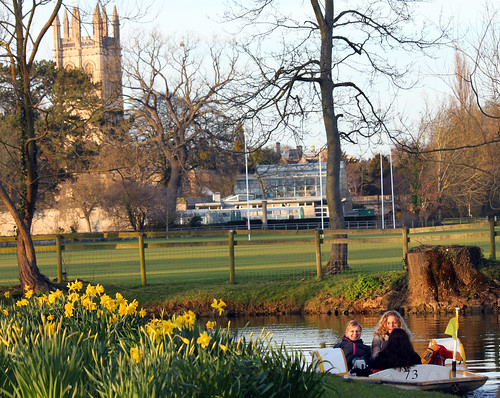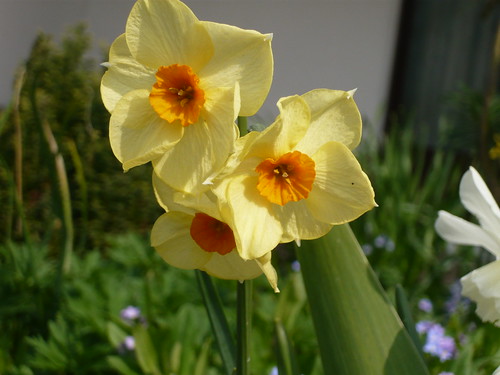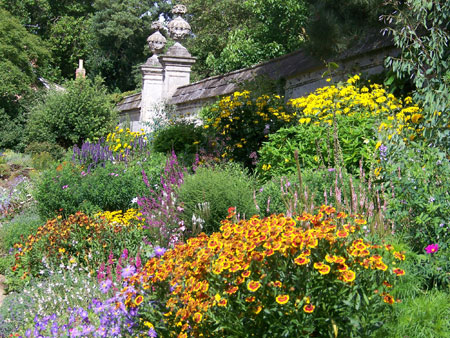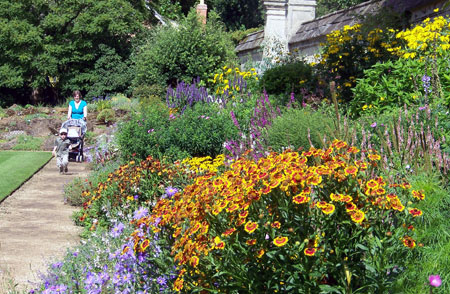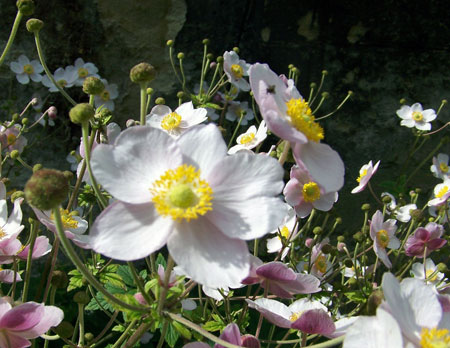Daffodil Daily
Daffodils by river Cherwell and Magdalen Tower in background
Daffodils by river
Daffodils in sun
Flowers for Mother’s Day
Mother’s day in the UK is fast approaching. If you have a habit of forgetting until the last minute, you can always rely on a bunch of flowers to save the day. But, rather than just a standard bunch of daffodils from the petrol station, what else would make your mother really happy and inspired to bake you more cakes?
Narcissus Tazetta. A late flowering daffodil. Warm spring has brought it out down here in Oxford. A lovely delicate flower with lovely colour contrast.
Plants for Hanging Baskets

A simple single colour Petunia gives a good effect.
The typical plants seen in hanging baskets include Lobelia, Petunia, Begonia, Marigolds, Fuchsias and Pelagoniums. The F1 varieties of these plants have a long flowering season making them ideal for summer hanging baskets.
Obviously in any hanging basket, trailing plants add an extra interest. For example a variegated ivy helps to offset and provide a balance to the more colourful varieties.
Plants for the Spring / Autumn Hanging Basket
Try Primulas, Violas, pansies, miniature conifers, ornamental cabbage and cyclamen. All can offer a good season of winter colour at a time when it is most appreciated.
Best Plants for Damp Shade

Fritilliary in damp shade
Previously we looked at plants for shady areas. Damp shade is another more specific problem area. In nature, we are likely to get damp shade in a woodland setting, with a combination of shady tree growth and a peaty soil.There is a combination of low light and potentially wet surfaces. Nevertheless, even if you have some damp shade, the following plants should work quite well.
Japanese Maple – Acer Palmatum. Japanese maples can offer excellent colour in autumn. They also make an excellent small tree / shrub for the small garden. Benefits from some mulch in winter to protect from heavy frosts.
Astilbe – False Goat’s Beard. An easy plant to grow. After flowering it’s deadseed heads are also quite attractive
Bleeding Heart – Dicentra Spectabilis. A lovely plant with delicate shaped flowers in Spring. Dies back in mid summer. Don’t forget where you planted it. Dicentra Spectabilis
Clematis ‘Kasmu’ Ideal for planting at the base of a shrub of tree. This clematis will grow up through the shrub offering wonderful flowers from July onwards.
Clematis Montana – likes to keep its roots cool, so damp shade helps here.Use a good Foliar feed every 7-10 days and a good root drenching weekly.
Lilly of the Valley – A lovely delicate white carpet flower. The main thing is it likes permanently moist soil
Fritilliary. The fritilliary is another flower which likes and needs a damp soil. Will flower fine in shade. Important it never dries out.
Hydrangea Serrata – a lovely compact Hydrangea
Cowslips / Primulas. Primulas do well in cool damp conditions, flowering in spring and also later in autumn. E.g. Primula viallii is a great plant for damp shade with wonderful purple flowers.
Related
- Shade tolerant plants
- Shrubs for dry shade
- Seeds for damp shade at T&M
- Plants for damp shade at Telegraph
Geranium Cranesbill Variety Review
The hardy perennial geranium is a good ground cover plant with many varieties to choose from. Do not confuse hardy Geraniums with Pelargoniums which are also sometimes referred to incorrectly as Geraniums.

Geraniums are one of the easiest and most versatile low growing plants. They are not fussy, but given a reasonable level of care they will reward the gardener with ground cover and 1 or 2 extended flowering periods.

Care for Geraniums
- After flowering cut back geraniums to their base. Feed and water and you will get a second flush of leaves and flowers later in the year.
- Geraniums are easy to divide. It is best done after the growing season is over in October. Just use a spade and divide their crown into two or three. If cut back, Geraniums can be divided at any time of they year but they will need more attention with watering.
- Geraniums grow best in full sun or partial shade but they are versatile and in our experience not that fussy.
- The great thing about Geraniums is that the mature plants seem relatively resistant to the most common pests – slugs and aphids. However, plug plants will need the usual protection from slugs and snails.

Geranium Plugs and Bare Roots
Dwarf hardy geraniums from Jersey direct
G. Johnsons Blue pictured is a strain of G. pratense and is a strong growing, self spreading plant. Mrs Kendall Clark is another clear blue but Rozanne has a longer flowering period from early summer to late autumn.
A pink geranium G. sanguenium is commonly found in many cottage gardens with it profuse pink flowers that have two flushes if cut back after the initial show. G Anna Folkard with lime green leaves has a trailing habit and needs some control in my garden.
Along with Johnsons Blue and Anna Folkard, Kashmir White has an Award of Garden Merit but I recommend you see plants in flower if you are looking to acquire it for a special colour or habit so that you make sure you are getting a good base stock that is worth the AGM.
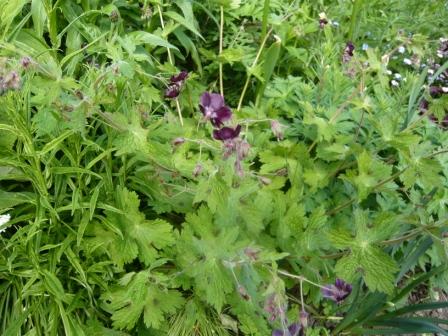
The black Mourning Widow G. Phaeum like shade and self seeds profusely. My stock is also a weedy short lived flowering example that I am trying to throw out.
Greanium renardii has sage green leaves and delicately purple-veined flowers.
Geranium himalayense ‘Birch Double’ is vigorous and versatile. this superb cranesbill tolerates almost any situation; even full shade. A mass of double purple-pink blooms stand above the delicately serrated foliage which turns to shades of burnt red and orange in autumn. will quickly blend with other herbaceous perennials to create colourful groundcover and looks equally attractive in herbaceous borders and shady woodland gardens. Height: 25cm (10â€). Spread: 60cm (24â€).
Geranium wallichianum ‘Sweet Heidi’ have rich purple, cup shaped blooms with clean, white centres that are decorated with distinct maroon veining. Forming loose mounds of attractive lobed foliage, this robust hardy geranium makes excellent ground cover through the front of informal borders

Geranium cinereum Laurence Flatman”
Biological Pest Control The Pros and Cons
Biological controls work best when it is warm and activity is highest. The more pests the more there is for the control to eat and treat.
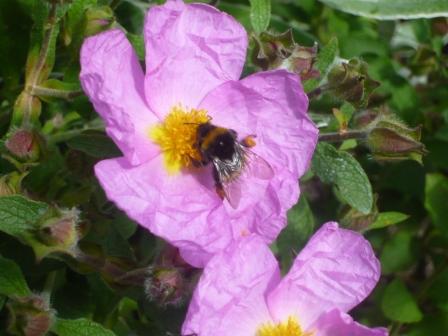
Biological controls are pest predators that can be bought mail order. Once introduced to the greenhouse or garden they can naturally take care of the relevant pest, enabling you to garden organically and free of pests. If you are considering using Biological pest control, these are the pros and cons
Advantages of Biological Control
- They are totally organic and provide a natural solution to your pests.
- They can be effective for upto two months.
- Some biological control you don’t have to buy mail order. E.g. planting marigolds may encourage hoverfly and they will eat aphids.
- Using Biological control means you won’t kill the natural predators like Thrushes for slugs, and ladybirds for aphids.
- They don’t create an eyesore like slug pellets do.
- Saves you having to kill pests, if you are squeamish at going round your lettuce leaves cutting slugs in half.
- Some insects may develop resistance to domestic sprays.
Disadvantages of Biological Control
Dealing With Ants
I am not anti ant but aren’t you glad ants are only small or with their organisation and strength they could rule our gardens.
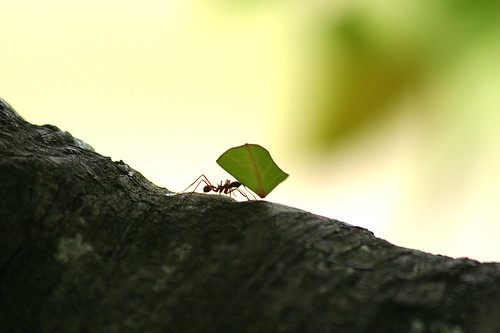
Photo by David Dennis CC
Ant at work. You have to admire the industry and organisation of ants.
Ants will be a common feature of any garden. To some extent, there is not much you can do about ants. In the garden they are a nuisance, but, sometimes it is just easier to live with them. Ants are more of a problem when they come into the house.
In the garden, you will notice ants, when areas of fine soil are created. (This actually makes very good topsoil). They are unlikely to do much lasting damage to your plants.
Generally, in the garden, I prefer to just tolerate ants, it isn’t really necessary to start using chemicals to kill them.
In the house they are more of a nuisance. But, before resorting to chemicals, simply try to block their entrances and keep areas clean of food.
Ants and Aphids
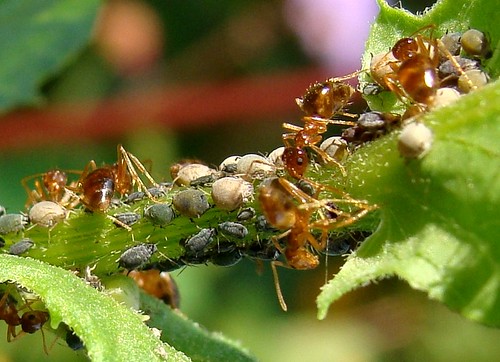
Photo by Martin Labar CC
This image shows ants and aphids working together. Ants are often attracted by aphids for the juice they excrete. In return, ants help protects aphids from predators.
How to Deal With Ants
- Ants follow trails of food. Make sure you don’t have trails of food to your house
- Ants do not manage to cross sticky substances. Using a jelly or slippery grease will prevent ants climbing in.
- Often the easiest and most effective way of preventing ants entering in the house is to locate the hole where they are managing to enter. (Often ants follow a trail and you can see them returning out the same way they came – carrying food with them.)
- If you find a colony of ants in a plant pot, you could drench the pot with water. (though make sure you don’t drown your plants.
- Boiling water on an ant hill may also kill many of the ants in their. Though in the garden it might not be worth it.
- Use Chemical pesticides.

Ant Spray at Amazon.co.uk
Common Garden Pests
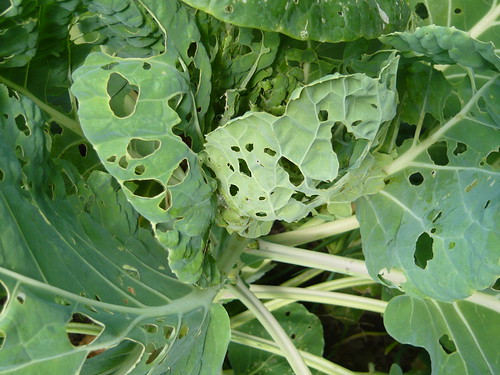
Sometimes we don’t see the pest, but we definitely see their work.
What are the most common garden pests we are likely to encounter and how can we deal with them?
Slugs
Anyone who has sought to admire their garden, will have come across the devastation that slugs can do. From new shoots of delphiniums to prize hostas and lettuce leaves, slugs can leave a trail of devastation before you can say ‘where are those slug pellets…’
Fortunately, slug populations can be controlled through both the popular slug pellet and more environmentally friendly organic methods. See: Tips for dealing with slugs
Snails
There’s not too much difference between slugs and snails when it comes to pests in the garden. I remember my grandma going out in the morning with a plastic bag full of salt, she could easily fill a bag with snails almost every week. The methods for dealing with snails are similar to slugs.
Oxford Botanic Garden Flowers – August
Economists agree this could be a good year for growth
Border at Botanic Gardens –
a reminder of the floral delights to come after the cold winter days.
Young kid inspects the border
Anemones


